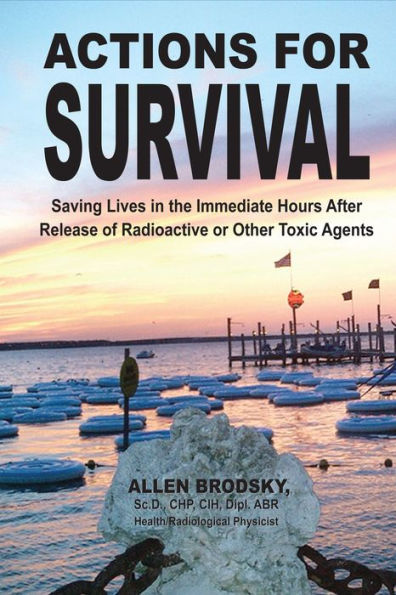
Actions for Survival: Saving Lives in the Immediate Hours After Release of Radioactive or Other Toxic Agents

Actions for Survival: Saving Lives in the Immediate Hours After Release of Radioactive or Other Toxic Agents
eBook
Available on Compatible NOOK devices, the free NOOK App and in My Digital Library.
Related collections and offers
Overview
This is a multilevel book that provides for the practicing professional, first responders, elected officials and decision-makers charged with the responsibility for protection of the civilian population. On its most important level, it makes available in plain language for all members of the general public the vital information necessary for survival following a nuclear terrorism event.
“This is a multilevel book designed to serve a multilevel readership. On one level, it provides for the practicing professional the scientific bases underlying protection of the population following an act of nuclear terrorism...On another level it provides first responders with the necessary information to counter an act of nuclear terrorism ...On yet another level it is a resource for elected officials and decision makers charged with the responsibility for protection of the civilian population. On its most important level, it makes available in plain language for all members of the general public the vital information necessary for survival following a nuclear terrorism event...chemical and bioterrorism as well ... This book is not a dry textbook ... Rather it sparkles with anecdotes and real life experiences.” — From the Foreword by Ronald L. Kathren, Professor Emeritus of Pharmaceutical Science, Washington State University

Product Details
| BN ID: | 2940045108195 |
|---|---|
| Publisher: | Allen Brodsky |
| Publication date: | 10/05/2012 |
| Sold by: | Smashwords |
| Format: | eBook |
| File size: | 9 MB |
About the Author
Dr. Allen Brodsky retired from full-time employment in 1986 but still mentors graduate students in their internships as an Adjunct (part-time) Professor of Radiation Science at Georgetown University. He also occasionally consults on radiation safety issues, but spends most of the time writing articles and books based on information accumulated during his 62-year career since completing college. The majority of his career has been in the fields called “health physics” and “medical physics.” In the field of health physics, his research, practice, and teaching has been related to: developing procedures and engineered facilities for protecting the health of workers and the public from harmful amounts of radiation; and writing necessary but reasonable safety regulations and guides so that our society can safely enjoy the benefits of radiation and radioisotope applications, in such practices as nuclear medicine diagnostics, radiation therapy, and industrial products that benefit humankind. In the field of medical physics, he developed methods of administering radiation for cancer therapy, and published procedural and staffing requirements for hospitals and medical institutions to ensure safe applications of radioactive material in diagnosis, therapy, and research. His education includes a bachelor’s degree in chemical engineering and master’s in physics from Johns Hopkins, and a doctorate in biostatistics and radiation health from the University of Pittsburgh. He also had a one-year graduate fellowship in Radiological Physics at Oak Ridge National Laboratory (1949-50), and is certified by the American Boards of Health Physics, Industrial Hygiene, and Radiology. His employment positions included Head, Health Physics Unit, Naval Research Laboratory; Physicist on Operations Ivy and Castle (first two H-bomb tests); Physicist in the Federal Civil Defense Administration; Health Physicist in the Atomic Energy Commission; Associate Professor in the Graduate School of Public Health, University of Pittsburgh; Radiation Physicist, Mercy Hospital, Pittsburgh; Adjunct Research Professor, Duquesne University School of Pharmacy; Health Physicist, U.S. Nuclear Regulatory Commission; Senior Scientist at SAIC performing radiation dose assessments of veterans exposed to fallout from atomic tests (retired from over 8 years full-time in this position in 1997 to March 2006); and Adjunct Professor of Radiation Science, Georgetown University (1987 to present). In addition, he has consulted for a variety of medical institutions, industrial facilities, and government research committees, and reviewed research proposals for four government agencies. He has many publications and his books include: Information for Controlling Radiation Emergencies, 1960, Atomic Energy Commission; CRC Handbooks of Radiation Measurement and Protection, Volumes I-IV, 1978-86, editor and contributor of many chapters; Review of Radiation Risks and Uranium Toxicity, 1996, RSA Publications; and Public Protection from Nuclear, Chemical, and Biological Terrorism, 2004, Medical Physics Publishing, Editor and author of nine chapters and appendices (a chapter summarizing his management and evaluation of radiation accidents can be reviewed on www.medicalphysics.org). This is his eighth book published commercially. Living with Insomnia, co-authored with his wife, Phyllis, was recently published by McFarland and Company, Inc., 2011. His work is summarized in Who’s Who in the World and other library biographical references. His awards for research, teaching, and service include: the Founder’s Award (1986), Fellow Award (1992), and the Robley D. Evans Medal (2001) of the Health Physics Society; the 1986 Failla Memorial Lecturer Award of the Greater New York Chapter of the Health Physics Society and the Radiological and Medical Physics Society; the Radiation Science and Technology Award (1993) of the American Nuclear Society; the Distinguished Graduate Award (2004) of the Graduate School of Public Health, University of Pittsburgh; and the Vicennial Medal of Georgetown University (2006). *I must admit that I wrote this myself. Due to lack of space I included only successful experiences and awards; listing my mistakes and failures would have required too many pages.
